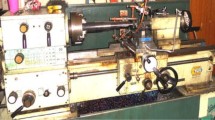Abstract
Turning process is one of the most complex manufacturing processes to simulate. The ability to accurately simulate turning processes depends on the availability of accurate workpiece material properties as well as the workpiece flow stress behavior change with deformation parameters such as strain, strain rate, and temperature. The goal of this paper is to determine the parameters of constitutive equation of flow stress for hardened AISI630 steel according to Johnson-Cook (JC) and power viscosity law (PVL) models. The numerical analysis of turning process has been done based on the finite elements method (FEM). Predicted results have been compared with experimentally determined data like, cutting force, tool tip temperature, and chip shape to validate the FE models. The numerical simulation results indicate that the adeptness of PVL model in forecasting the plastic behavior of AISI630 steel is quite acceptable and the predicted results are very close to experimental results in comparison with JC model. In addition, the results showed that the serrated chip morphology was accurately predicted over a large range of machining parameters using PVL model. Furthermore, FE analysis and PVL model have been used to predict cutting forces and tool temperature during different turning conditions. It has been found that for low feed rates, the chip form will be changed from continuous to saw-tooth form, e.g., at 0.1 mm/rev feed, with increasing cutting speed from 28 to 62 m/min the chip form was changed from continuous to saw-tooth type. In addition, during machining at cutting speed of 28 m/min, the cutting force is stable, while at cutting speed of 62 m/min, the resultant cutting force is fluctuating. This fluctuating force along with the build-up edge formation increases machined surface roughness at a speed of 62 m/min unexpectedly.


























Similar content being viewed by others
References
Zerilli FJ, Armstrong RW (1987) Dislocation-mechanics-based constitutive relations for material dynamics calculations. J Appl Phys 61:1816–1825. https://doi.org/10.1063/1.338024
Liu R, Melkote S, Pucha R, Morehouse J, Man X, Marusich T (2013) An enhanced constitutive material model for machining of Ti-6Al-4V alloy. J Mater Process Technol 213:2238–2246. https://doi.org/10.1016/j.jmatprotec.2013.06.015
Demir E, Mercan C (2018) A physics-based single crystal plasticity model for crystal orientation and length scale dependence of machining response. Int J Mach Tools Manuf 134:25–41. https://doi.org/10.1016/j.ijmachtools.2018.06.004
Johnson GR, Cook WH (1983) A constitutive model and data for metals subjected to high strains, high strain rates, and high temperatures. Proceedings of the 7th International Symposium on Ballistics, Hague, Netherlands, pp 541–547
Calamaz M, Coupard D, Girot F (2008) A New material model for 2D numerical simulation of serrated chip formation when machining titanium alloy Ti–6Al–4V. Int J Mach Tools Manuf 48:275–288. https://doi.org/10.1016/j.ijmachtools.2007.10.014
Sima M, Özel T (2010) Modified material constitutive models for serrated chip formation simulations and experimental validation in machining of titanium alloy Ti–6Al–4V. Int J Mach Tools Manuf 50(11):943–960. https://doi.org/10.1016/j.ijmachtools.2010.08.004
Hor A, Morel F, Lebrun JL, Germain G (2013) Modelling, identification and application of phenomenological constitutive laws over a large strain rate and temperature range. Mech Mater 64:91–110. https://doi.org/10.1016/j.mechmat.2013.05.002
Marusich TD, Ortiz M (1995) Modelling and simulation of high-speed machining. Int J Numer Methods Eng 38:3675–3694. https://doi.org/10.1002/nme.1620382108
Rhim SH, Oh SI (2006) Prediction of serrated chip formation in metal cutting process with new flow stress model for AISI 1045 steel. J Mater Process Technol 171:417–422. https://doi.org/10.1016/j.jmatprotec.2005.08.002
Johnson GR, Cook WH (1985) Fracture characteristics of three metals subjected to various strains, strain rates, temperatures and pressures. Eng Fract Mech 21(1):31–48. https://doi.org/10.1016/0013-7944(85)90052-9
Cockcroft MG, Latham DJ (1968) Ductility and the workability of metals. J Inst Met 96:33–39
Osovski S, Rittel D, Rodríguez-Martínez JA, Zaera R (2013) Dynamic tensile necking: Influence of specimen geometry and boundary conditions. Mech Mater 62:1–13. https://doi.org/10.1016/j.mechmat.2013.03.002
AdvantEdge 7.1 User’s Manual (2015) Third Wave Systems Inc
Xi Y, Bermingham M, Wang G, Dargusch M (2014) SPH/FE modeling of cutting force and chip formation during thermally assisted machining of Ti6Al4V alloy. Comput Mater Sci 84:188–197. https://doi.org/10.1016/j.commatsci.2013.12.018
Vyas A, Shaw MC (1999) Mechanics of saw-tooth chip formation in metal cutting. J Manuf Sci Eng 121:163–172. https://doi.org/10.1115/1.2831200
Belhadi S, Mabrouki T, Rigal JF, Boulanouar L (2005) Experimental and numerical study of chip formation during straight turning of hardened AISI 4340 steel. Proc IMechE Part B J Eng Manuf 219(7):515–524. https://doi.org/10.1243/095440505X32445
Morehead MD, Huang Y (2007) Chip morphology characterization and modeling in machining hardened 52100 steels. Mach Sci Technol 11:335–354. https://doi.org/10.1080/10910340701567289
Herrera V, Fuentes LG, Alvarado OC, Rodriguez AS, Sanchez EG (2016) Hot Ductility of the 17-4 PH Stainless Steels. J Mater Eng Perform 25(3):1041–1046. https://doi.org/10.1007/s11665-016-1895-9
Brown WF, Mindlin H, Ho CY (eds) (1997) Aerospace structural metals handbook, vol 1. Steels, Purdue University, West Lafayette
Thakare A, Nordgren A (2015) Experimental study and modeling of steady state temperature distributions in coated cemented carbide tools in turning. Procedia CIRP 31:234–239. https://doi.org/10.1016/j.procir.2015.03.024
Author information
Authors and Affiliations
Corresponding authors
Additional information
Publisher’s note
Springer Nature remains neutral with regard to jurisdictional claims in published maps and institutional affiliations.
Rights and permissions
About this article
Cite this article
Ebrahimi, S.M., Araee, A. & Hadad, M. Investigation of the effects of constitutive law on numerical analysis of turning processes to predict the chip morphology, tool temperature, and cutting force. Int J Adv Manuf Technol 105, 4245–4264 (2019). https://doi.org/10.1007/s00170-019-04502-7
Received:
Accepted:
Published:
Issue Date:
DOI: https://doi.org/10.1007/s00170-019-04502-7




